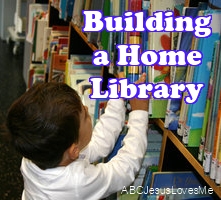Yesterday I explained the importance of building a home library. Today I will show you how I organize ours!
I organize just for the sake of organizing sometimes. While this mad-obsession has cooled down due to a lack of time, the teacher in me still likes everything cataloged and systematic.
So when I got the hair-brained idea to organize our home library, I wondered if it was a wise use of my time or just filling some crazy “need” that I had.
I am happy to report that I have not regretted for one moment the time I spent.
Here is how we manage our home library.
Board books – All board books are kept in baskets or in the bathroom on a shelf. Potty training is an excellent time to pour literature into your child. The books are easy for the kiddos to grab to either browse on their own or to be read to.
Paperback and Hardback books – These books are kept in crates that line a bedroom wall. Plastic storage crates or the wooden ones stack very nicely and hold a lot of books. We also have an old bookshelf that was found at a flea market and renailed together.
The books are organized by reading level. Kindergarten, 1st Grade, 2nd Grade, etc. You can find the reading level of most classic books for free online. I use two different websites:
Upon finding out the reading level of the book, I place a colored sticker on the spin of the book. Each grade level has a different color. Also, I write the level of the book on the first page as sometimes the stickers fall off. If your child’s school will use DRA, AR, GRL, or SRI testing, I encourage you to place those numbers in the front of the book as well so you don’t have to return to the website once the child is in school.
2 Year Curriculum – 1st Grade
3 Year Curriculum – 1.5 Grade
4 Year Curriculum – 2nd Grade
5 Year Curriculum – 2.5 Grade
And when your child begins to read, it is important that the child reads on the his/her level to help the child be successful but also growing in his/her reading ability. It is also necessary to read books that are on a child’s interest level. While a book on spiders may be at the appropriate reading level, it may not peak all 2-year-old’s interest.
This doesn’t mean that you stop reading books that are under the child’s reading level. It just means that the majority of books shouldn’t fall too far above or below.
Now that two of my children are reading, I will ask them to choose a certain book based upon the reading level. But if I want to focus on fluency, I will chose a level below their actual reading level. By coloring coding the books, there is not question which books are acceptable.
The color coding also helps my children know where to place the books when they are done with them. They have learned to place the colored sticker so that it can be seen.
Depending on the number of books that you have in your home, this could take a few moments or a few hours. For us, it has been well worth the time.
![]()
Source on reading level information – West Virginia Dept of Education




